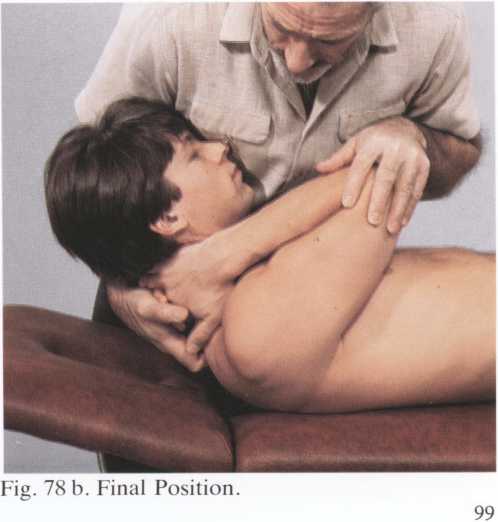99 (122)

5.2.2A.
Specific techniąue to increase ven-tral flexion of Tl on T2. P supine.

Starting Position: P: Supine; hips and knees flexed; right heel resting on left knee with left foot against the raised foot of the couch; (this position flattens P’s lumbar lordosis); hands clasped on napę of neck (or folded across chest) to stabilize cervical spine; wedge-shaped support stabilizes the caudal vertebrae of the segment treated (here T2). T: Standing facing P’s left side.
Grip: T’s left hand grips P’s elbows and adjusts the specific segment with smali “rocking” movements (moving P’s elbows cranially and caudally) so that the force is directed at the cranial vertebra (here Tl). T’s right index finger palpates the movement between the spinous processes. (If necessary, T’s index and ring fingers may then stabilize the transverse processes with T’s middle.finger against the spinous process of P’s upper vertebra). P’s head and neck are supported by T’s right hand and forearm.
Procedurę: Using this grip, T asks P to exhale while he/she gradually and fully ventrally flexes Tl on T2. As P exhales, T uses left hand to push P’s elbows in a cranial and dorsal direction and right hand to simultaneously puli in a cranial and ventral direction.
Stimulation of Antagonists: T retains grip and asks P to exhale, look down, and then move further in the direction of stretching. T resists that move-ment to stimulate P’s antagonists.
Notes: If the treatment, using ventral (or dorsal) flexion, is of a lower thoracic segment, P may need to be in a morę upright position to prevent upper body from excessively weighting at the segment treated (see techniąue 5.4.1A, p. 105).
If P has shoulder or elbow pain, he/she may fold arms across chest while T uses the alternative grip of techniąue 5.4. IB, p. 106.

Fig. 78 a. Starting Position.

Wyszukiwarka
Podobne podstrony:
36 (519) 3.2.4A. Specific technique to increase ven-tral flexion of C2 on C3. P sitting. Starting Po
37 (498) 3.2.4B. Specific techniąue to increase ven-tral flexion of C2 on C3. P supine. ► Starting P
31 (637) 3.2.2A. Specific technique to increase ven-tral flexion of the occiput on the atlas. P sitt
41 (472) 3.3.2A. Specific techniąue to increase ven-tral flexion with rotation and lateral flexion t
32 (619) 3.2.2B. Specific techniąue to increase ven-tral flexion of the occiput on the atlas. P sitt
33 (623) 3.2.2C. Specific techniąue to increase ven-tral flexion of the occiput on the atlas. P supi
34 (544) 3.2.3A. Specific technique to increase ven-tral flexion of the atlas on the axis. P sitting
35 (522) 3.2.3B. Specific techniąue to increase ven-tral flexion of the atlas on the axis. P supine.
88 (153) 4.2.1. Specific technique to increase ven-tral glide of the mandible (j)rotru-sion). Inabil
42 (439) 3.3.2B. Specific technique to increase ven-tral flexion with rotation and lateral flexion t
43 (434) 3.3.2C. Specific technique to increase ven-tral flexion with rotation and Iateral flexion t
90 (158) 4.2.3A. Specific technique to increase ven-tral and caudal movement of the mandible. Slight
60 (278) 3.6.2A. Specific technique to increase dorsal flexion with rotation and lateral flex-ion to
46 (412) 3.5.2A. Specific technique to increase dorsal flexion of the occiput on the atlas. P sittin
58 (289) 3.6.1A. Non-specific techniąue to increase dorsal flexion with rotation and later-al flexio
61 (265) 3.6.2B. Specific techniąue to increase dorsal flexion with rotation and lateral flex-ion to
62 (263) 3.6.2C. Specific techniąue to increase dorsal flexion with rotation and lateral flex-ion to
63 (253) 3.6.2D. Specific technique to increase dorsal flexion with rotation and lateral flex-ion to
64 (250) 3.7.1A. Non-specific technique to increase dorsal flexion with rotation to the right a
więcej podobnych podstron